A Humla Journey
In 2013 three of us headed over to Nepal to try our luck on the Humla. It turned out to be a very successful trip and one I wont forget in a hurry. Here is a video I knocked up from the trip. Enjoy.








In 2013 three of us headed over to Nepal to try our luck on the Humla. It turned out to be a very successful trip and one I wont forget in a hurry. Here is a video I knocked up from the trip. Enjoy.
The Andy Duff Memorial Kaituna Challenge is held annually in the height of summer in Okere Falls. Andy Duff was a local raft guide and kayaker and the race was started by his friends after he passed away while traveling in America. The race is a medley of mass starts beginning with short boats followed by long boats, tandems, sledgers/swimmers then finally rafting.
The racing can get a little bit hectic with everybody looking for a chance to take out the titles but it is all in good spirit with everybody looking out for each other.
Geni took out the women’s sledging title.
I have competed in this fun race for the last 3 years but this was the first time I entered in all 5 disciplines which was pretty full on but I was stoked to make it to the finish line in all 5 races especially the sledging!
My favourite race this year was definitely the raft race, with unprecedented carnage nearly every raft which entered flipped at some point down the river! We were in 3rd position coming up to the waterfall behind the NZ Men’s team and the team from River Rats Rafting. All 3 boats flipped and we managed to overtake the River Rats crew by getting our boat upright at a much faster pace. So in the end we finished in 2nd place behind the NZ men’s team which wasn’t too bad considering that they were recently crowned fastest team IN THE WORLD on that stretch of river.
Sam and Rob going for the carnage award.
Every year a special carnage trophy is handed out to the person or team who create the most epic/memorable carnage during the race. The carnage trophy used to belong to Andy Duff himself so in a way it is the best award. This year the award went to Mike Hudson (the guy with a red helmet in the photo above) who attempted the sledge race for the first time and had some epic downtime underneath the waterfall. Also see below the winner’s of last year’s carnage award.
Also a big kia ora to Douglas McCormick for the photos and for organising the race, thanks Douglas!
By Phil Clegg
I suffer fairly badly from painfully cold hands when kayaking in cold conditions and so for me to paddle in the UK in winter I need some form of protection from the cold. There are various items available, from gloves and mitts to pogies. I have tried numerous versions of them all but the ones that work best for me are neoprene pogies. The ones that I use are the Palm Neo Mitts. They have several features which make them stand out from the others.
The Neo Mitt is a full length pogie made from 3 mm neoprene with a thermofibre lining. It attaches to your paddle with Velcro and protects your hands from the cold. It has a wide cuff for easy entry and a pull tab to help put it on. As with all pogies it keeps your hands warmer than gloves and it lets you feel the paddle shaft.
Compared to other neoprene pogies they are quite thin which for me is a real benefit as the weight can affect you paddling. Most noticeably when you try to increase your paddle rate to say catch a wave, the extra weight can slow you down. Palm have managed to keep them thin and warm by using their thermofibre lining which not only adds to the warmth but also reduces the painful rubbing that unlined neoprene can cause. This has the benefit of letting you paddle with a nice relaxed grip which is much better for your paddling than the normal clenched grip you tend to use with other neoprene pogies to prevent rubbing sores on your hands.
The pogies also benefit from being able to be used in a few of different ways. If it isn’t too cold you can roll the top of the pogies down so that you can very quickly get your hands in and out which can be very useful for say taking photos. This also vents the pogies well letting your hands breath and not get too soft from being sweaty all day. If it’s colder you can unroll them which makes them seal well against your dry top cuffs keeping your hands nice and warm and most of the water out. And if it all gets a bit to much and you need your hands free for a while you can push them into the middle of your paddle shaft and carry on unencumbered.
Here’s to a good winter of paddling.
As I was able to spend my fourth winter in a row in Chile it was my first trip where I was guiding customers through this beautiful country on the west coast of South America.
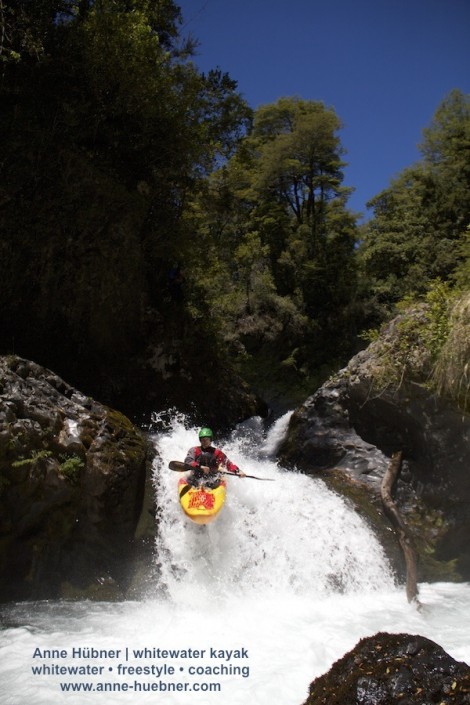
Daniel on the last drop of the lower palguin
First destination of our journey was Pucon where we did some warm up paddling on the surrounding rivers. Ellies B&B offered a lovely ambience with the view on the Volcano Villarica to relax after the long trip to get there.
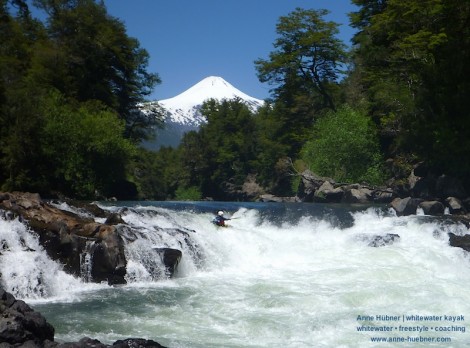
Peter in the “volcano drop” of the Trancura
In the first few days the group got a taste of some big volume rapids on the Trancura, they mastered the difficulty of running their first waterfalls on the Palguin and they got in touch with some remoteness of the Chilean wilderness on the Maichin.
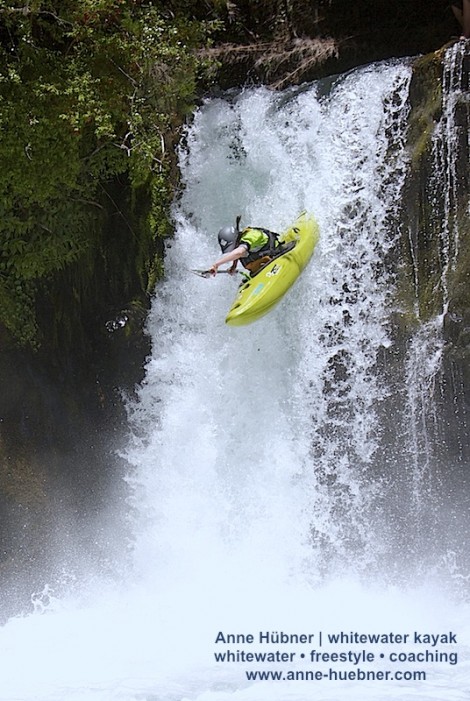
the highest drop of the upper Plaguin, photo: Michael Sommerauer
After Christmas, which would have been described as a summer garden barbecue party in Europe, we started to travel south. With a stopover at the Rio Fuy where the group improved their waterfalls skills our next main destination was the Rio Futaleufu, which is called one of worlds finest kayak destinations for a good reason.
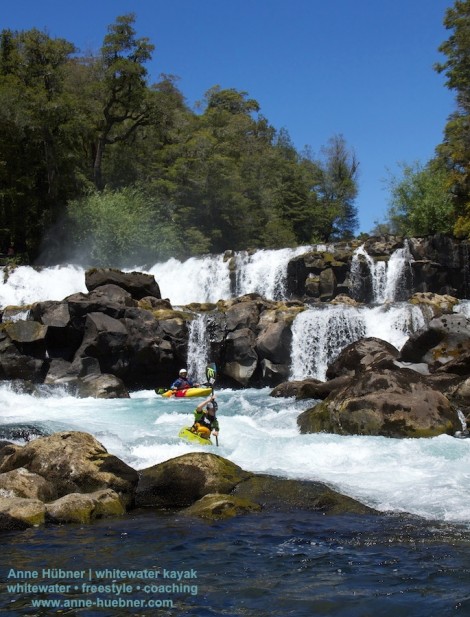
upper Fuy, photo: Michael Sommerauer
Driving down south took us a whole day and leaded us through pleasant fjords using three ferries as well as down the Carretera Austral and through the “Parque Pumalin” – a gorgeous nature park in the Chaiten region. Unluckily the typical Patagonian constant rain didn´t spare us but once arrived at the Cara del Indio camp we considered ourselves fortune by claiming the last free Cabana that evening.

pole position on the ferry
After a good sleep we started to have our first real big volume paddling day down the Bridge to El Macal section on the next morning. As we barely find any comparable whitewater back home I observed some hectic paddling till we reached the take out. So we decided that another day of warm up paddling down the same section would be necessary till everyone got familiar with that kind of exploding waves and whirlpools and felt ready to venture through the canyon and down the complete 46 kilometer long whitewater section of the Futaleufu, just in time for closing paddeling on New Year´s Eve. Tired but happy to collect the “golden medal” of the Futa we rewarded ourselves with an original Chilean “Asado” – a whole lamb grilled for several hours by the owner of our Camp.
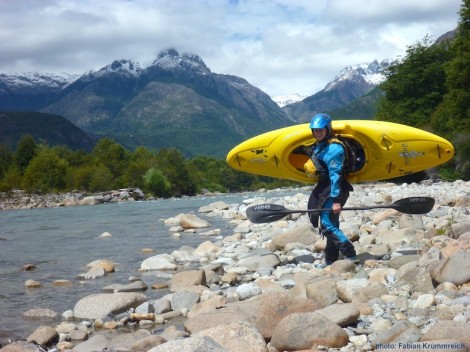
Almut in her great Palm gear and Dagger Mamba at the put in for the Rio Azul, photo: Fabian Krummreich
So the group started off their paddling year 2014 by getting more and more comfortable on the extraordinary whitewater of the Futa day-by-day. Due to the continuous rain even the Azul came a little bit up and became an enjoyable run. So relaxing in the traditional Hot-Tub high up on the cliff over the Futa was the last missing thing of the Futa-experience which got ticked off the list before we had to loac up the truck to start our journey back up north again.
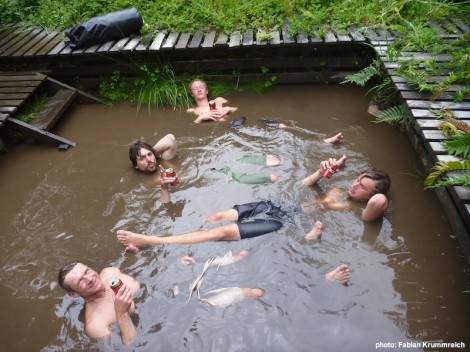
the boys having fun in the mud tub of the Termas Amarillo, photo: Fabian Krummreich
On the way our plan was to paddle the Michimahuida, which offers an entire day on the river filled with numerous rapids and scenic waterfalls coming in from the glacier on the sides in the remote Patagonian wilderness. Unfortunately the river was running a little bit to high for us on that day so we took out after the first few kilometres just where the road leaves the river and spent the rest of the day in the nearby “Termas Amarillo”. While half of the group kept relaxing in the nice and clear naturally hot water of the Termas few others felt more pleased resting in the natural mud pool. In the end of the day the sun finally managed to burn all those clouds of the seven five days away and brought us a beautiful last evening on our wild camp on the beach close to Chaiten.

last wild camping spot on the beach close to Chaiten, photo: Fabian Krummreich
Back in Pucon we spent our last few days on the more and more drying Rios Fuy, Trancura and Palguin and tried to absorb as much sun as we could before we had to fly back to winter in the cold and dark Europe.
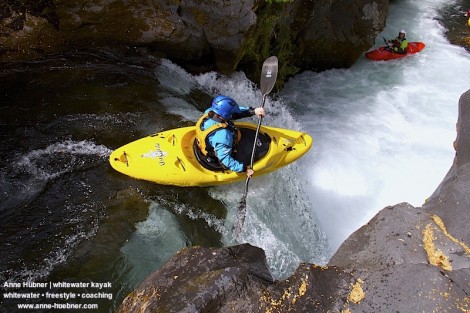
Almut boofs one of the nicest drops of the lower Palguin
Chile is and stays on of the best places on earth to escape Europeans winter season for all paddlers who enjoy paddling class IV whitewater. One can find everything paddlers heart desires – from steep volcano rock built low volume creeks to excellent big volume whitewater. As one of the safest South American countries Chile fascinates with its clean and clear rivers, tasty food, dry and warm climate and tons of breathtaking landscape.
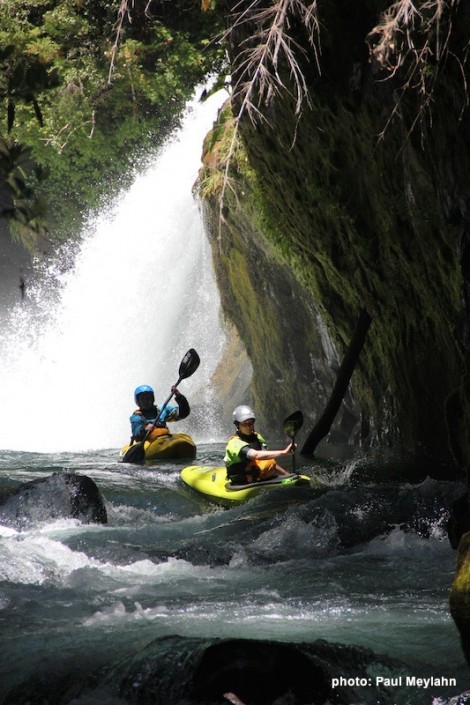
Almut following me down the upper Plaguin, photo: Paul Meylahn
I will be back next year for sure.
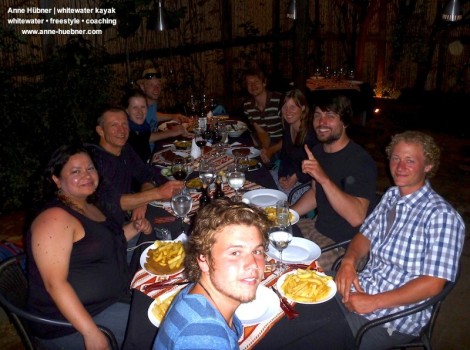
Thanks to the Crew and…
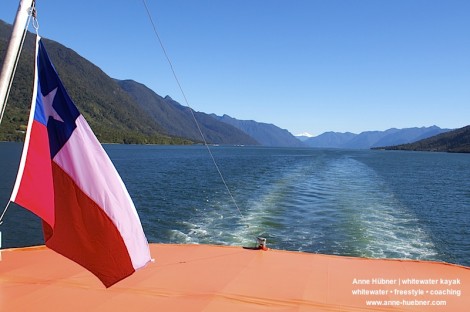
… bye bye Chile
Living in Whistler in winter means I don’t have much chance for going kayaking. It also means I have more time to edit the videos I took in the past. So I finally managed to complete this “memoir” of an amazing time I had in Washington State and British Columbia in the past year. Seriously, thinking back, I can’t really remember much from when I was 10 years old and I’m counting on these videos to help my memory 20 years from now. My first time in North America was fun and exciting and I’m looking forward to even more of it in the upcoming season.
Thanks to everybody who kayaked with me, especially Max Blackburn, Greg Daspher, Marlow McGregor, Richard Kemble and Cory Boux, who I spent the most time with and who were especially patient putting up with me.
Thanks Palm for your amazing gear and for helping me being able to do what I love doing so much. It won’t be long until I’ll be putting my Stikine Immersion Suit back on again and I’m really looking forward to it!
Another year spent ringing in the New Year in county Kerry, and further confirmation that it must be one of the greatest places to be for a paddler at that time of year. Almost every university kayaking club in Ireland makes the journey south to Ireland’s Kingdom for a week of paddling and shenanigans. These University boaters are joined by a host of other paddlers from around Ireland to create a festival atmosphere. For those in the UK, think of a week long NSR but with creek boating and nice accommodation. UK Resident boaters James Smith, Dan Rea-Dickens and Louise Fingleton decided to see what the hype was all about this year and needless to say they were not disappointed.
Kerry and Cork has the highest mountains in Ireland so the area naturally produces some of the best creeking Ireland has to offer. Tough rivers like the Flesk and Gaddagh keep the advanced boaters happy but there are many easier rivers for any level of paddler to enjoy. If we get a completely dry week which has not happened for a number of years, Kerry hosts some of the best surf beaches in Ireland.

Kerry became altogether too much for James. Here he is showing off the comfort of his Palm kit. Photo by David Glasswell.
A couple hundred boaters congregate on a small town by the name of Glenbeigh and rent houses here, the reason for this is that it is within walking distance of the legendary Ross Inn pub. A premises with seemingly bottomless leniency to the antics of whitewater paddlers. The nightly walks there with everybody in high spirits seem like a pilgrimage to a sacred place. You really just have to experience it for yourself.
This year it was decided by myself and the rest of the Irish Whitewater Race League organizers that we would incorporate the Colm Johnson Memorial Flesk Extreme Race into the Kerry New Years Festival. This is the hardest and most exclusive race in the League. We spent days checking and rechecking forecasts hoping that we would be able to run the event. The rain absolutely pounded down the night before flooding the whole region and a nice large gathering was found at the put in of the river in the morning. The problem was now was that the river had rocketed too high to safely run the full race. We instead ran a shorter version on a very fun section at the start. Here are the results:
Needless to say, after the race concluded we had a awesome run down the full river at a big and bouncy level! Special mention to 16 year old Robert Kierans who ran it for the first time and styled everything!
Besides the river Flesk there are many other classic rivers in the region to get done and we were fortunate to paddle with the Kerry river Guru that is David Glasswell. Here is a photo taken by Dan Rea-Dickens of the main falls of the Owengar River.
Since returning to my hometown of Galway I was also recently able to check out a freestyle feature on our home run the Boluisce River. It has not been working very frequently in past years but we were shocked by how good of a feature it actually is! The focus lately has been predominantly on freestyle as Irish Team Trials are scheduled to take place in the next 10 days, some great athletes will be there this year and it should be a great competition.
Well that’s all for now, thanks to Palm as always for keeping me warm and comfortable in the cold waters.
Andrew : )
The event was held in Rotorua New Zealand and our athlete village was a very nice touring campsite on the outskirts of town. It had its own Thermal hot pools and swimming pool and our little hut was right next to both! SCORE! The opening ceremony started as all should, with a Haka!